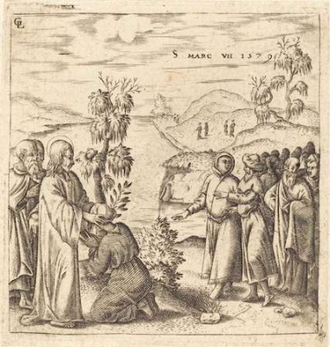Gospel in Art: 'Ephphatha', that is, 'Be opened.'

Christ Healing a Deaf Man, by Léonard Gaultier, 1579 © National Gallery of Art, Washington DC
Source: Christian Art
Gospel of 8 September 2024
Mark 7:31-37
Returning from the district of Tyre, Jesus went by way of Sidon towards the Sea of Galilee, right through the Decapolis region. And they brought him a deaf man who had an impediment in his speech; and they asked him to lay his hand on him. He took him aside in private, away from the crowd, put his fingers into the man's ears and touched his tongue with spittle. Then looking up to heaven he sighed; and he said to him, 'Ephphatha', that is, 'Be opened.' And his ears were opened, and the ligament of his tongue was loosened and he spoke clearly. And Jesus ordered them to tell no one about it, but the more he insisted, the more widely they published it. Their admiration was unbounded. 'He has done all things well,' they said 'he makes the deaf hear and the dumb speak.'
Reflection on the engraving
When writing these daily reflections, I am often tempted to immediately 'spiritualise' the miracles that Jesus performed. Yes, this is an important aspect when reading the Gospels, but we should not forget that these miracles, such as today's healing of the deaf man, actually occurred and involved real physical healing. We sometimes tend to play down the physical aspect of these miracles. God cares for our souls, but also cares about our bodies and physical welfare. Our bodies are given to us to do God's work.
After Jesus healed the man, he asked the witnesses not to tell others about the miracle. However, the people who had brought the deaf and mute man to Jesus ignored his request. The more Jesus urged them to keep it quiet, the more they spread the news. Though Jesus granted their request, they did not honour his. The man brought to Jesus could not listen because he was deaf. Yet, as we know from our own experiences, having the ability to hear does not always equate to truly listening. Our failure to listen can affect both what we say and how we say it. Notably, once Jesus had restored his hearing, the man could speak clearly for the first time. This highlights the close connection between hearing and speaking. Similarly, the more we genuinely listen to someone, the more our words to them are likely to be supportive and life-giving.
Our featured French print by Léonard Gaultier, published in 1579, captures the moment when Jesus places his fingers in the deaf man's ears. Some bystanders witness the miracle, while in the distance some of them have already gone out to spread the word. Gaultier was a prolific artist, producing over eight hundred different prints. In this print, we see the Sea of Galilee in the distance.
That day, not only were the deaf man's ears opened, but also his heart, mouth, mind, and entire life were opened up.
LINKS
Gospel in Art: https://christian.art/
Today's Reflection: https://christian.art/daily-gospel-reading/mark-7-31-37-2024-2/


















